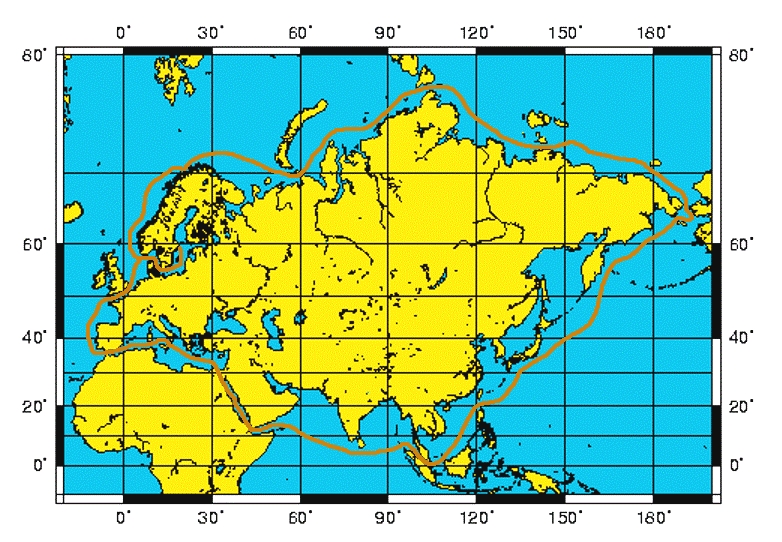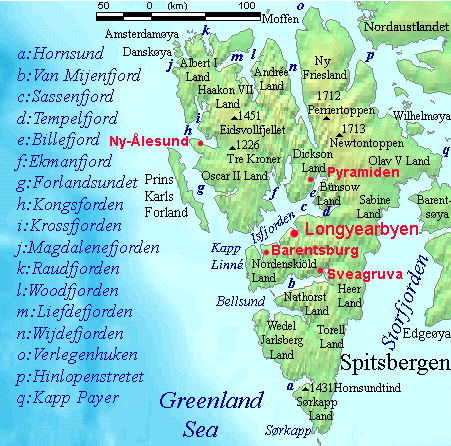|
Nordenskiöldbreen
Nordenskiöldbreen (Nordenskiöld Glacier) is a glacier in Spitsbergen, Svalbard. It is named after Finnish geologist Adolf Erik Nordenskiöld (1832–1901). Geography Nordenskiöldbreen is located between Dickson Land and Bünsow Land. The glacier flows roughly southwestwards and is long and wide. It has its terminus in Adolfsbukta, a branch of Billefjorden. See also * List of glaciers A glacier ( ) or () is a persistent body of dense ice that is constantly moving under its own weight; it forms where the accumulation of snow exceeds its ablation (melting and sublimation) over many years, often centuries. Glaciers slowly defor ... References Glaciers of Spitsbergen {{Spitsbergen-glacier-stub ... [...More Info...] [...Related Items...] OR: [Wikipedia] [Google] [Baidu] |
Billefjorden
Billefjorden is the central fjord of the three branching from the innermost part of the Isfjord, Svalbard, Isfjorden to the northeast, in Svalbard, Norway. It is 30 km long and 5–8 km wide. Billefjorden lies between Dickson Land to the northwest and Bünsow Land in the southeast. Located on its northwestern shore is the former Russian coal mining community of Pyramiden (abandoned in 1998). To the northeast is Nordenskiöldbreen (Nordenskiöld Glacier). At its northeastern extreme is Adolf Bay. The fjord is named after the Netherlands, Dutch whaler Cornelius Claeszoon Bille, who is mentioned as being active in 1675 by the Dutch whaler Cornelius Gisbert Zorgdrager. Originally another bay (now known as Adventfjorden) had been labeled as ''Klass Billen Bay'', but Nils Christoffer Dunér, Dunér and Adolf Erik Nordenskiöld, Nordenskiöld moved it to its present location. The fjord is the site of the Billefjorden Fault Zone, which continues to the north and separates Svalba ... [...More Info...] [...Related Items...] OR: [Wikipedia] [Google] [Baidu] |
Adolf Erik Nordenskiöld
Nils Adolf Erik Nordenskiöld (; 18 November 183212 August 1901) was a Finland-Swedish aristocrat, geologist, mineralogist and Arctic explorer. He was a member of the noble Nordenskiöld family of scientists and held the title of a friherre (baron). Born in the Grand Duchy of Finland in the Russian Empire, he was forced to move to Sweden in 1857 due to his political activity, where he became a member of the Parliament of Sweden and of the Swedish Academy. He led the ''Vega'' Expedition along the northern coast of Eurasia in 1878–1879. This was the first complete crossing of the Northeast Passage. Initially a troubled enterprise, the successful expedition is considered to be among the highest achievements in the history of Swedish science. Nordenskiöld family The Nordenskiölds were an old Fenno-Swedish family, and members of the nobility. Nordenskiöld's father, Nils Gustaf Nordenskiöld, was a Finnish mineralogist, civil servant and traveller. He was also a member ... [...More Info...] [...Related Items...] OR: [Wikipedia] [Google] [Baidu] |
Spitsbergen
Spitsbergen (; formerly known as West Spitsbergen; Norwegian language, Norwegian: ''Vest Spitsbergen'' or ''Vestspitsbergen'' , also sometimes spelled Spitzbergen) is the largest and the only permanently populated island of the Svalbard archipelago in northern Norway in the Arctic Ocean. Constituting the westernmost bulk of the archipelago, it borders the Arctic Ocean, the Norwegian Sea and the Greenland Sea. Spitsbergen covers an area of , making it the largest island in Norway and the List of islands by area, 36th largest in the world. The administrative centre is Longyearbyen. Other settlements, in addition to research outposts, are the mining community of Barentsburg, the research community of Ny-Ålesund, and the mining outpost of Sveagruva. Spitsbergen was covered in of ice in 1999, which was approximately 58.5% of the island's total area. The island was first used as a whaling base in the 17th and 18th centuries, after which it was abandoned. Coal mining started at the e ... [...More Info...] [...Related Items...] OR: [Wikipedia] [Google] [Baidu] |
Svalbard
Svalbard ( , ), previously known as Spitsbergen or Spitzbergen, is a Norway, Norwegian archipelago that lies at the convergence of the Arctic Ocean with the Atlantic Ocean. North of continental Europe, mainland Europe, it lies about midway between the northern coast of Norway and the North Pole. The islands of the group range from 74th parallel north, 74° to 81st parallel north, 81° north latitude, and from 10th meridian east, 10° to 35th meridian east, 35° east longitude. The largest island is Spitsbergen (37,673 km2), followed in size by Nordaustlandet (14,443 km2), (5,073 km2), and Barentsøya (1,288 km2). Bear Island (Norway), Bjørnøya or Bear Island (178 km2) is the most southerly island in the territory, situated some 147 km south of Spitsbergen. Other small islands in the group include Hopen (Svalbard), Hopen to the southeast of Edgeøya, Kongsøya and Svenskøya in the east, and Kvitøya to the northeast. The largest settlement is Longyearbyen, situated in Isfjor ... [...More Info...] [...Related Items...] OR: [Wikipedia] [Google] [Baidu] |
Arctic Ocean
The Arctic Ocean is the smallest and shallowest of the world's five oceanic divisions. It spans an area of approximately and is the coldest of the world's oceans. The International Hydrographic Organization (IHO) recognizes it as an ocean, although some oceanographers call it the Arctic Mediterranean Sea. It has also been described as an estuary of the Atlantic Ocean. It is also seen as the northernmost part of the all-encompassing world ocean. The Arctic Ocean includes the North Pole region in the middle of the Northern Hemisphere and extends south to about 60°N. The Arctic Ocean is surrounded by Eurasia and North America, and the borders follow topographic features: the Bering Strait on the Pacific side and the Greenland Scotland Ridge on the Atlantic side. It is mostly covered by sea ice throughout the year and almost completely in winter. The Arctic Ocean's surface temperature and salinity vary seasonally as the ice cover melts and freezes; its salinity is the ... [...More Info...] [...Related Items...] OR: [Wikipedia] [Google] [Baidu] |
Glacier
A glacier (; or ) is a persistent body of dense ice, a form of rock, that is constantly moving downhill under its own weight. A glacier forms where the accumulation of snow exceeds its ablation over many years, often centuries. It acquires distinguishing features, such as crevasses and seracs, as it slowly flows and deforms under stresses induced by its weight. As it moves, it abrades rock and debris from its substrate to create landforms such as cirques, moraines, or fjords. Although a glacier may flow into a body of water, it forms only on land“Glacier, N., Pronunciation.” Oxford English Dictionary, Oxford UP, June 2024, https://doi.org/10.1093/OED/7553486115. Accessed 25 Jan. 2025. and is distinct from the much thinner sea ice and lake ice that form on the surface of bodies of water. On Earth, 99% of glacial ice is contained within vast ice sheets (also known as "continental glaciers") in the polar regions, but glaciers may be found in mountain ranges on ever ... [...More Info...] [...Related Items...] OR: [Wikipedia] [Google] [Baidu] |
Dickson Land
Dickson Land is a land area between Isfjorden and Wijdefjorden at Spitsbergen, Svalbard Svalbard ( , ), previously known as Spitsbergen or Spitzbergen, is a Norway, Norwegian archipelago that lies at the convergence of the Arctic Ocean with the Atlantic Ocean. North of continental Europe, mainland Europe, it lies about midway be .... It forms a peninsula between the Isfjorden branches Billefjorden and Dicksonfjorden. Dickson Land is named after Oscar Dickson. References Geography of Svalbard Spitsbergen {{Spitsbergen-geo-stub ... [...More Info...] [...Related Items...] OR: [Wikipedia] [Google] [Baidu] |
Bünsow Land
Bünsow Land is a land area at the inner end of Isfjorden at Spitsbergen, Svalbard. It forms a peninsula between Billefjorden and Sassenfjorden and Tempelfjorden Tempelfjorden is a fjord branch at the inner end of Sassenfjorden, a part of Isfjorden (Svalbard), Isfjorden at Spitsbergen, Svalbard. It is located between Sabine Land and Bünsow Land. The fjord is named after the mountain Templet (Svalbar .... Bünsow Land is named after Friedrich Christian Ernestus Bünsow. Bünsow Land is included in the Sassen – Bünsow Land National Park. References Geography of Svalbard Peninsulas of Spitsbergen {{Spitsbergen-geo-stub ... [...More Info...] [...Related Items...] OR: [Wikipedia] [Google] [Baidu] |
List Of Glaciers
A glacier ( ) or () is a persistent body of dense ice that is constantly moving under its own weight; it forms where the accumulation of snow exceeds its ablation (melting and sublimation) over many years, often centuries. Glaciers slowly deform and flow due to stresses induced by their weight, creating crevasses, seracs, and other distinguishing features. Because glacial mass is affected by long-term climate changes, e.g., precipitation, mean temperature, and cloud cover, glacial mass changes are considered among the most sensitive indicators of climate change. There are about 198,000 to 200,000 glaciers in the world. Catalogs of glaciers include:World Glacier Inventory* World Glacier Monitoring ServiceGlobal Land Ice Measurements from Space (GLIMS) Glacier Database Glaciers by continent
|




